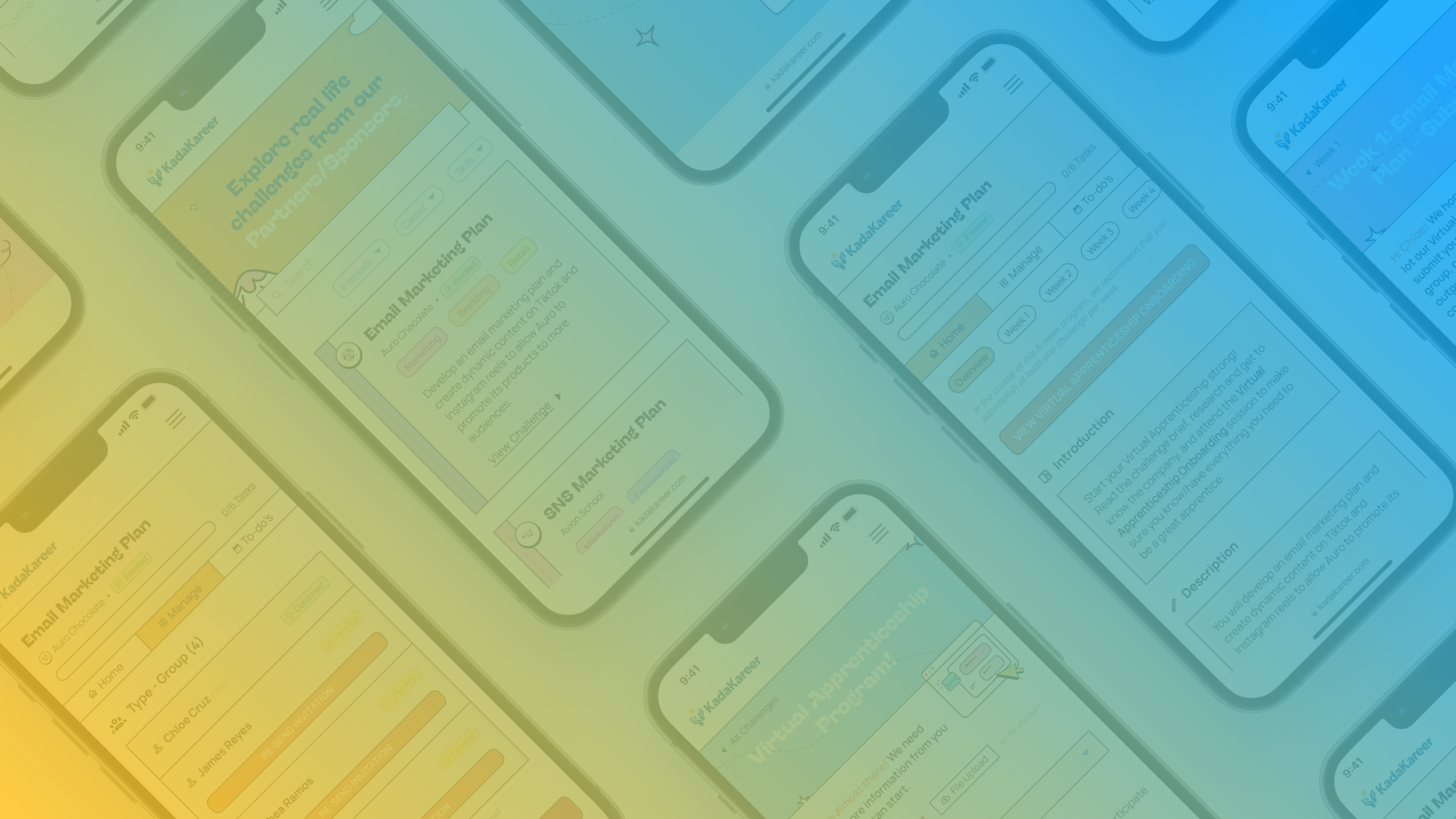
KADAKAREER
Designing From Scratch
My team and I at H4I partnered up with KadaKareer, a non-profit organization based in the Philippines, with the mission of supporting underserved youth in sustainably launching their careers. KadaKareer recognizes the severe gaps in the higher education system, in the Philippines.
To address this challenge, as the sole designer, in less than four months, I created over 55 high-level mobile and desktop interfaces from scratch. Previously, KadaKareer's VirApp resources were scattered across five different platforms; I strategically reimagined and consolidated these interfaces into a unified, seamless experience. During the entire design process I was committed to a continuous cycle of improvement and refinement, incorporating insights gathered from over 10 rounds of user testing.
The overarching objective was clear: to deliver students an exceptionally user-friendly gateway to a comprehensive suite of resources, cutting-edge tools, and personalized coaching services.
My designs are currently in the process of being implemented and are live on their website.
Date
Sept 2022 - Dec 2022
My Role
Product Designer
Tools
Figma
Team
Designer: Maxine Tam
Software Developers: Arman Rafati, Vishruth Raj, Daniel Moon, Liza George, Anya Parekh, Jacky Park
Project Manager: Praneeth Guduguntla

PERSONALIZED CAREER EXPLORATION
HOME + CHALLENGE CARDS
With our Home page, we welcome our new Kadets as they embark on their Virtual Apprentice Program journey. For each partnering business, we present challenge cards that include a summary of the challenge, and its alignment with specific career paths, and features a filtering system that enables Kadets to explore opportunities tailored to their specific interests, career aspirations, and skill sets.
EMPOWERING INFORMED CHOICES
OVERVIEW + CHALLENGE SIGN UP
Within each challenge, Kadets have the opportunity to explore a comprehensive overview containing explicit instructions for the challenge and gain insights into the company behind the challenge. Once they've assessed the alignment of the challenge with their interests and career goals, Kadets can proceed to register by filling out a form, where they have the option to proceed individually or in a group with their preferred groupmates.

SEAMLESS CHALLENGE MANAGEMENT
CHALLENGE PAGE
After enrolling in a challenge, Kadets can view all of the challenge’s components. Here, they can explore weekly tasks, oversee their groupmates, monitor collaboration invites' status, and utilize an organized To-Do section. This section plays a pivotal role in ensuring user understanding of their challenge/tasks while ensuring that their experience remains consistently efficient, highly effective, and crystal clear.
SIMPLIFIED TASK SUBMISSION
WEEKLY TASK SUBMISSION
Kadets can submit their weekly tasks through a form at the beginning of each week's tab. Upon submitting their task, the submission button at the top of the page will vanish, making way for a submission section. This section showcases the submission link, and any comments from the reviewer, and provides an option to re-edit the submission. Furthermore, the task status bar, positioned in the top menu of the challenge interface, updates with a green bar, simultaneously displaying the count of completed tasks. This not only enhances user confidence but also offers an additional layer of confirmation regarding task progress and completion.

HANDOFF & EXISTING PROBLEMS
CONTEXT
My team and I joined Kadakareer’s VirApp (Virtual Apprenticeship) project during the Ideation process. Leveraging prior user research conducted by KadaKareer’s team, I synthesized key findings and takeaways. These insights later informed my design decisions when conceptualizing and crafting an intuitive mobile and desktop platform catered to users of all backgrounds, including those who may not have extensive experience with the given applications and technologies.
The VirApp is currently hosted via third-party applications on Google Forms, Google Drive, Notion, Discord, and Gmail.
CURRENT PAIN POINTS - OLD SYSTEM
DESIGN GOALS

HOW MIGHT WE...
create an organized platform where all actions and information are centralized so that both program students and Kadakareer staff may efficiently access and edit all program material accordingly?
DESIGN SYSTEM
ACCESSIBILITY ISSUES
MAIN COLOR PALETTE
TYPOGRAPHY
HEADING
BODY TEXT
ITERATIONS & HIGH-FI’S
IDEATION
Considering the time constraints associated with handing off to our computer developers, I decided to dive straight into crafting the high-fidelity designs. In the beginning stages of my ideation, I created numerous iterations, meticulously crafting various visuals and features that would enrich the overall user experience of VirrApp, while ensuring that the design language harmonized with KadaKareer's prevailing aesthetic.

USER TESTING
RECRUITING PARTICIPANTS + SETTING THE ENVIRONMENT
After developing the initial iterations of high-fidelity screens, my project manager and I conducted extensive user testing, totaling 10 sessions. To ensure a representative sample of our target user base, I recruited high school or college students with a Filipino background. During our communication with participants, I emphasized the importance of choosing a natural study-friendly environment for our calls. My aim with this was for them to replicate their natural studying habits as closely as possible.
USER TESTING (CONT.)
DATA COLLECTION + FEEDBACK
Throughout the user testing process, I presented participants with a series of scenarios that simulated common user journeys. These scenarios encompassed tasks such as searching for specific challenge cards, accessing information on specific weeks, and more
Primary data collection focus
Task Completion Rate
(Time)
Success Rates
Frustrations
Contentment Level
The feedback received was overwhelmingly positive, indicating that users found the entire experience and design seamless, intuitive, and user-friendly. However, as users progressed through their assigned tasks, it was apparent that certain elements, such as buttons, needed to be repositioned for improved accessibility. This iterative approach ensured that every facet of the interface was honed to perfection, ensuring a seamless alignment with the diverse needs and preferences of our user base.
REFLECTING
What an experience this was! I may confidently say that I have grown both as a designer and as a problem solver.
LESSON LEARNED...
WORKING DIRECTLY WITH A TEAM OF DEVELOPERS
I am truly appreciative of the opportunity to work directly with computer developers, as it allowed me to hone in on my design thinking while also considering the functionality of particular designs and timelines for the implementation of features. My interactions with them have expanded my understanding of how design fits into the broader context of a product's development cycle. Additionally, I have a deeper appreciation for the delicate balance between aesthetics and functionality in creating user-centered experiences.
USER TESTINGS → ITERATIONS
Throughout the design process, I learned the invaluable lessons of user testing at any stage of my designs, whether that be low, mid, or high-fidelity screens. The continuous feedback loops were instrumental in crafting the best final design through an iterative design process. These tests served as a constant reminder of the end-users and the purpose behind my designs, reinforcing my commitment to designing with my users in mind.
NOTABLE HIGHLIGHTS...
COMMUNICATION
Through consistent communication, which took the form of bi-weekly meetings with the team in the Philippines and collaborative dev-nights, I was able to nurture innovative ideas with unique approaches by bouncing ideas off of them and drawing inspiration from their insight.
IF I HAD MORE TIME...
USER TEST
Given more time, I would have liked to conduct additional user testing on the second design iteration to optimize the user experience further. In addition, I would have aimed for more in-person testing sessions, as we conducted more than 75% of the user testing over Zoom due to scheduling and location constraints, to ensure a comprehensive and holistic evaluation of the design.
MORE SCREENS
Given more time, I would have liked to delved deeper into the user journey, extending my design exploration. In particular, I would like to create a series of designs that would address the post-submission phase of the Kadets' journey, focusing on the feedback and revision processes to enhance the overall user experience.
























